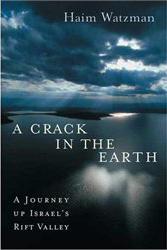Israel - Palestine
° Israel ° Ashdod ° Eretz ° Elat (Eilat) ° Haifa ° Jaffa ° Jerusalem ° The Dead Sea Scrolls° The Genius, Art and Calligraphy of the Jews ° The Hoopoe Bird
The Dead Sea Scrolls
The Dead Sea scrolls are one of the greatest discoveries in archaeological history. The ancient texts first came to light in 1947, when a young goat herder stumbled upon some manuscripts hidden in a cave at Khirbat Qumrān—about a dozen miles (19 kilometers) from the ancient West Bank city of Jericho.
The leatherbound papyrus manuscripts include hundreds of distinct works. The predominantly Hebrew writings are a wellspring of information about the Holy Land from the third century B.C. to the second century A.D., including the birth and growth of Christianity and the new faith's religious and social relationships to Judaism.
As the scrolls' value became known, local Bedouin nomads and archaeologists raced to find more. To date the area has yielded scrolls from 11 different caves. The finds include a nearly complete Hebrew Old Testament Bible, which has allowed scholars to date the existence of that text to no later than A.D. 70. In addition, the Copper Scroll was a sort of archaeological treasure map guiding scholars to dozens of other hidden texts. And the Temple Scroll contained detailed construction plans for the Temple of Jerusalem.
Many scholars believe that the documents belonged to a Hebrew religious sect that lived in the area during the first century A.D. The scrolls' guardians may have hidden them from the Romans during the First Jewish Revolt (A.D. 66 to 70). Since their discovery the scrolls have often been a source of controversy among scholars. Texts of the more complete documents were published soon after their discovery but most of the scrolls have deteriorated into thousands of tiny fragments. Access to these texts was for many years tightly controlled by a small group of scholars working under the Jordan Department of Antiquities and later, after Israel took over the area in the 1967 Arab-Israeli War, the Israel Antiquities Authority.
In 1991 the Huntington Library in San Marino, California, allowed scholars unlimited access to its complete collection of scroll photographs—finally opening the priceless texts to study by the larger community of eager scholars.
The Dead Sea Scrolls

Since their discovery, the Dead Sea Scrolls have been not only invaluable objects of study for scholars but also sought-after public attractions, drawing multitudes of people interested in viewing these fascinating ancient documents. This exhibition catalog features photos and descriptions of the twelve Scroll fragments and over 80 artifacts from the collections of the Israel Antiquities Authority on display at the Public Museum of Grand Rapids in spring 2003. Allowing everyone to experience this stunning exhibit firsthand, this catalog contains a mix of striking visual images, basic information on the Scrolls, and outstanding original essays by leading Dead Sea Scrolls scholars. Bastiaan Van Elderen introduces the history of the Scrolls.
Pnina Shor and Lena Libman describe the conservation of the Scrolls. James VanderKam discusses the importance of calendars in the life of the Qumran community. Emanuel Tov documents for the first time in his own words the history of the publication of the Scrolls, including the controversy surrounding their release, the reasons behind delays in their publication, and other provocative stories.
1899. World's Fleet. Boston Daily Globe
Lloyds Register of Shipping gives the entire fleet of the world as 28,180 steamers and sailing vessels, with a total tonnage of 27,673,628, of which 39 perent are British.
| Great Britain | 10,990 vessels, total tonnage of 10,792,714 |
| United States | 3,010 vessels, total tonnage of 2,405,887 |
| Norway | 2,528 vessels, tonnage of 1,604,230 |
| Germany | 1,676 vessels, with a tonnage of 2,453,334, in which are included her particularly large ships. |
| Sweden | 1,408 vessels with a tonnage of 643, 527 |
| Italy | 1,150 vessels |
| France | 1,182 vessels |
For Historical Comparison
Top 10 Maritime Nations Ranked by Value (2017)
| Country | # of Vessels | Gross Tonnage (m) |
Total Value (USDbn) |
|
|---|---|---|---|---|
| 1 | Greece | 4,453 | 206.47 | $88.0 |
| 2 | Japan | 4,317 | 150.26 | $79.8 |
| 3 | China | 4,938 | 159.71 | $71.7 |
| 4 | USA | 2,399 | 55.92 | $46.5 |
| 5 | Singapore | 2,662 | 64.03 | $41.7 |
| 6 | Norway | 1,668 | 39.68 | $41.1 |
| 7 | Germany | 2,923 | 81.17 | $30.3 |
| 8 | UK | 883 | 28.78 | $24.3 |
| 9 | Denmark | 1,040 | 36.17 | $23.4 |
| 10 | South Korea | 1,484 | 49.88 | $20.1 |
| Total | 26,767 | 87.21 | $466.9 | |













 Copyright ~ 1998-2018.
Copyright ~ 1998-2018. 